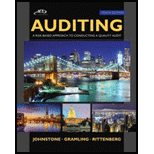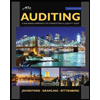
a.
Introduction: Auditing means the inspection of financial accounts of the company to determine if the records are accurate as per the rules and regulations of accounting or not. There are two types of auditors, i.e., internal auditors and external auditors, that carry out the
To Explain: Contingent fee.
b.
Introduction: Auditing means the inspection of financial accounts of the company to determine if the records are accurate as per the rules and regulations of accounting or not. There are two types of auditors, i.e., internal auditors and external auditors, that carry out the auditing process.
To state: The reason why contingent fees is not acceptable by the external auditors.
Want to see the full answer?
Check out a sample textbook solution
Chapter 4 Solutions
Auditing: A Risk Based-Approach to Conducting a Quality Audit
- explain properly all the answer for General accounting question Please given fastarrow_forwardPlease help me solve this financial accounting problem with the correct financial process.arrow_forwardPlease explain the solution to this general accounting problem using the correct accounting principles.arrow_forward
- The Cambridge Manufacturing's next expected dividend, D1, is $2.85; its growth rate is 6.2 percent, and its stock currently sells for $46.30. New stock can be sold to net the firm $43.05 per share. a. What is Cambridge's percentage flotation cost? b. What is Cambridge's cost of new common stock? Provide answerarrow_forwardCan you explain the process for solving this financial accounting question accurately?arrow_forwardIf Sierra Manufacturing had their total liabilities increased by $8,400 and stockholders' equity decreased by $3,700 during a period of time. Then total assets must have changed by what amount and direction during that same period? Helparrow_forward
- Please explain the solution to this general accounting problem with accurate principles.arrow_forwardQuaker Industries has a cost of goods manufactured of $550,000, beginning finished goods inventory of $150,000, and ending finished goods inventory of $200,000. The cost of goods sold is: A. $400,000 B. $500,000 C. $550,000 D. $600,000arrow_forwardA change in accounting estimate is applied? (A) Retrospectively (B) Neither prospectively nor retrospectively (C) Both prospectively and retrospectively (D) Prospectively solve thisarrow_forward
 Auditing: A Risk Based-Approach to Conducting a Q...AccountingISBN:9781305080577Author:Karla M Johnstone, Audrey A. Gramling, Larry E. RittenbergPublisher:South-Western College Pub
Auditing: A Risk Based-Approach to Conducting a Q...AccountingISBN:9781305080577Author:Karla M Johnstone, Audrey A. Gramling, Larry E. RittenbergPublisher:South-Western College Pub Auditing: A Risk Based-Approach (MindTap Course L...AccountingISBN:9781337619455Author:Karla M Johnstone, Audrey A. Gramling, Larry E. RittenbergPublisher:Cengage Learning
Auditing: A Risk Based-Approach (MindTap Course L...AccountingISBN:9781337619455Author:Karla M Johnstone, Audrey A. Gramling, Larry E. RittenbergPublisher:Cengage Learning- Business/Professional Ethics Directors/Executives...AccountingISBN:9781337485913Author:BROOKSPublisher:Cengage
 College Accounting (Book Only): A Career ApproachAccountingISBN:9781337280570Author:Scott, Cathy J.Publisher:South-Western College Pub
College Accounting (Book Only): A Career ApproachAccountingISBN:9781337280570Author:Scott, Cathy J.Publisher:South-Western College Pub




